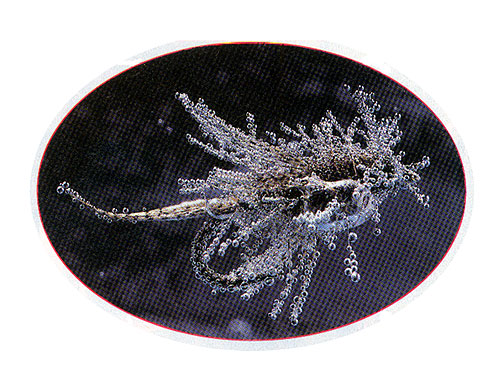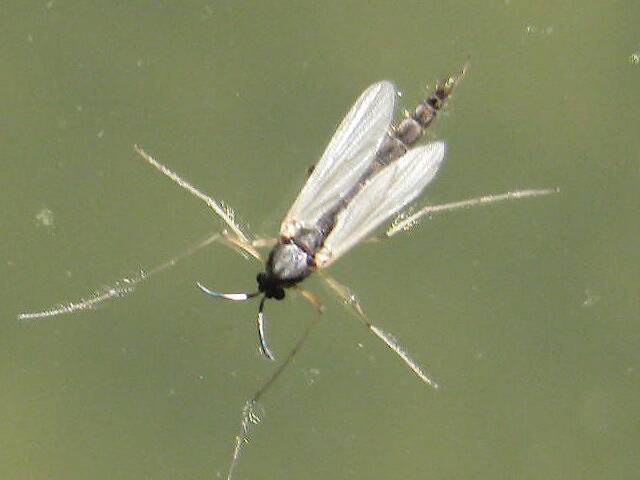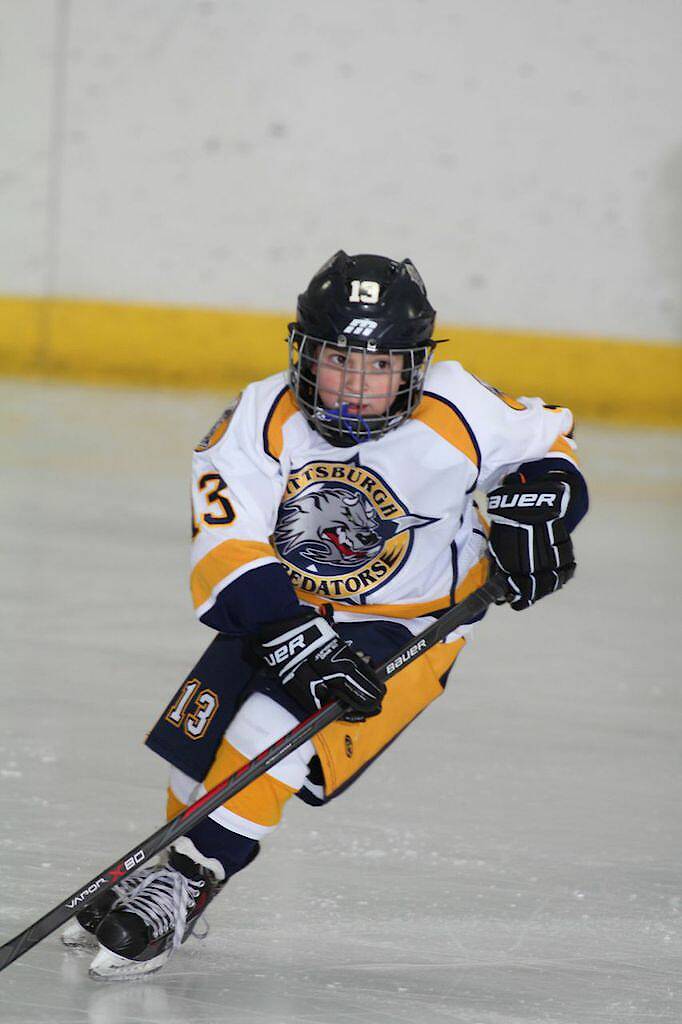
Blue-winged Olives
Baetis
Tiny Baetis mayflies are perhaps the most commonly encountered and imitated by anglers on all American trout streams due to their great abundance, widespread distribution, and trout-friendly emergence habits.
Featured on the forum

This wild-looking little thing completely puzzled me. At first I was thinking beetle or month larva, until I got a look at the pictures on the computer screen. I made a couple of incorrect guesses before entomologist Greg Courtney pointed me in the right direction with Psychodidae. He suggested a possible genus of Thornburghiella, but could not rule out some other members of the tribe Pericomini.

Troutnut is a project started in 2003 by salmonid ecologist Jason "Troutnut" Neuswanger to help anglers and
fly tyers unabashedly embrace the entomological side of the sport. Learn more about Troutnut or
support the project for an enhanced experience here.
Wbranch on Jan 31, 2010January 31st, 2010, 4:48 am EST
If the premise of the Emergent pupa is to emulate an air bubble on the pupa as it rises in the water column why is the "bubble" always created with tan Antron or tan Aunt Lydia's yarn rather than a translucent material like pearl Krystal Flash or clear organza to better imitiate the silvery aspect of the air bubble trapped in the pupal form and legs?
Catskill fly fisher for fifty-five years.
Troutnut on Jan 31, 2010January 31st, 2010, 5:06 am EST
I think the idea is not to imitate bubbles, but to actually trap real air bubbles within the material. Apparently Antron does that well.
Jason Neuswanger, Ph.D.
Troutnut and salmonid ecologist
Troutnut and salmonid ecologist
Wbranch on Jan 31, 2010January 31st, 2010, 6:01 am EST
"but to actually trap real air bubbles"
Now why didn't I think of that! I tied four with pearl midge flash and will try and get a photo. They look good so now I'll have both trapped air and the light reflecting quality of the faceted flash material. Thanks for your insightful comments.
Now why didn't I think of that! I tied four with pearl midge flash and will try and get a photo. They look good so now I'll have both trapped air and the light reflecting quality of the faceted flash material. Thanks for your insightful comments.
Catskill fly fisher for fifty-five years.
Falsifly on Jan 31, 2010January 31st, 2010, 7:05 am EST
“the discovery of a new type of synthetic, a nylon filament known as Antron made by Du Pont, provided fresh hope. The material had two major qualifications: it was translucent and it reflected light. The filaments underwater looked perfect; by every laboratory measurement they simulated the air bubble exactly.”
Quoted from “Caddisflies”
By Gary LaFontaine
However, I do remember reading somewhere that Antron a three sided (trilobal) nylon does attract and hold air. I use it on my midge pupa to simulate the wing pad during emergence.
Falsifly
When asked what I just caught that monster on I showed him. He put on his magnifiers and said, "I can't believe they can see that."
When asked what I just caught that monster on I showed him. He put on his magnifiers and said, "I can't believe they can see that."
Shawnny3 on Feb 1, 2010February 1st, 2010, 12:05 am EST
In my experience materials such as these hold many small air bubbles rather than one big one, which is what the naturals feature, I believe. I would be rather surprised if the trapped air looked like the air trapped by the naturals.
I have often wondered the same thing, Matt, about the various colors LaFontaine used for the air bubble. While I've always thought, as you do, that the pattern would look better with something pearl colored or transparent, I will defer to LaFontaine's imitations for one major reason: He spent a great deal of time actually looking at both the naturals and his imitations underwater, while I have not.
-Shawn
I have often wondered the same thing, Matt, about the various colors LaFontaine used for the air bubble. While I've always thought, as you do, that the pattern would look better with something pearl colored or transparent, I will defer to LaFontaine's imitations for one major reason: He spent a great deal of time actually looking at both the naturals and his imitations underwater, while I have not.
-Shawn
Jewelry-Quality Artistic Salmon Flies, by Shawn Davis
www.davisflydesigns.com
www.davisflydesigns.com
Softhackle on Feb 1, 2010February 1st, 2010, 1:56 pm EST
Hi Everyone,
This has been a subject that has always interested me. First, Because Vern Hidy suggested trapping air in his flymphs, many years before Gary did. He used spikey dubbing fur and use to dry the fly on tissue to make it catch air as it hit the water. He called the phenomenon a "Hydrofuge". Hidy definitely believed this worked to attract more fish.
Unfortunately, I have yet to see any photographic proof that the bubble occurs in hatching pupae. If there IS a photo somewhere, I'd like to see it.
I have seen a photo of a hatching pupae where the rear end of the shuck seems to be holding air, but no bubble encasing the hatching insect.
In an article, some time ago in one of the outdoor sporting mags, there was a suggestion about coating wet flies and nymphs with Scotch Guard. The results can be seen in this photo:

The author claimed doing so increased fish response.
Mark
This has been a subject that has always interested me. First, Because Vern Hidy suggested trapping air in his flymphs, many years before Gary did. He used spikey dubbing fur and use to dry the fly on tissue to make it catch air as it hit the water. He called the phenomenon a "Hydrofuge". Hidy definitely believed this worked to attract more fish.
Unfortunately, I have yet to see any photographic proof that the bubble occurs in hatching pupae. If there IS a photo somewhere, I'd like to see it.
I have seen a photo of a hatching pupae where the rear end of the shuck seems to be holding air, but no bubble encasing the hatching insect.
In an article, some time ago in one of the outdoor sporting mags, there was a suggestion about coating wet flies and nymphs with Scotch Guard. The results can be seen in this photo:

The author claimed doing so increased fish response.
Mark
"I have the highest respect for the skilled wet-fly fisherman, as he has mastered an art of very great difficulty." Edward R. Hewitt
Flymphs, Soft-hackles and Spiders: http://www.troutnut.com/libstudio/FS&S/index.html
Flymphs, Soft-hackles and Spiders: http://www.troutnut.com/libstudio/FS&S/index.html
Gutcutter on Feb 2, 2010February 2nd, 2010, 12:13 am EST
that is a cute picture, although i've personally never seen a hatch of cat puke.
seriously - what are some brand names of "antron" that you can buy at a fly shop? i thought that dupont stopped manufacturing some of its nylon specialty materials. is this one of them?
seriously - what are some brand names of "antron" that you can buy at a fly shop? i thought that dupont stopped manufacturing some of its nylon specialty materials. is this one of them?
All men who fish may in turn be divided into two parts: those who fish for trout and those who don't. Trout fishermen are a race apart: they are a dedicated crew- indolent, improvident, and quietly mad.
-Robert Traver, Trout Madness
-Robert Traver, Trout Madness
Wbranch on Feb 2, 2010February 2nd, 2010, 2:09 am EST
Isn't Z-lon a trilobal fiber? YBO sells this in many colors. Years ago Dan Bailey used to sell a product called "LureFlash" that was also labeled "Antron Body-Wool". He says "this is the real McCoy with parallel strands of genuine Trilobal Antron Yarn." It was sold in at least ten yard lengths wrapped on cardstock. I have seven colors and enough for the rest of my tying days. Angler's Workshop sells spooled Antron yarn in eighteen colors. Also what sounds like a Z-lon product; "Sparkle Emerger Yarn (in hanks) Crinkly trilobal antron in hank form." Hope that helps you.
BTW the "LureFlash" product is stamped "Made in England" on the back of the card. I Googled it and it is still sold in many flyshops in the UK.
BTW the "LureFlash" product is stamped "Made in England" on the back of the card. I Googled it and it is still sold in many flyshops in the UK.
Catskill fly fisher for fifty-five years.
Gutcutter on Feb 2, 2010February 2nd, 2010, 3:28 am EST
matt
i'm glad you cleared that up for me.
other than grannoms, i really don't specifically fish many caddis hatches but there are always enough around to warrant bringing a box of dries and emergers of generic colors. for example - last spring i was fishing a great paralepts hatch but the fish were ignoring many different offerings. then i noticed the caddis. i switched to a caddis dry with a bubble sheath emerger as a dropper and started to catch fish - almost all on the dropper. i have tied my bubble sheaths w z-lon and was wondering if it was the same thing.
i'm glad you cleared that up for me.
other than grannoms, i really don't specifically fish many caddis hatches but there are always enough around to warrant bringing a box of dries and emergers of generic colors. for example - last spring i was fishing a great paralepts hatch but the fish were ignoring many different offerings. then i noticed the caddis. i switched to a caddis dry with a bubble sheath emerger as a dropper and started to catch fish - almost all on the dropper. i have tied my bubble sheaths w z-lon and was wondering if it was the same thing.
All men who fish may in turn be divided into two parts: those who fish for trout and those who don't. Trout fishermen are a race apart: they are a dedicated crew- indolent, improvident, and quietly mad.
-Robert Traver, Trout Madness
-Robert Traver, Trout Madness
Oldredbarn on Feb 2, 2010February 2nd, 2010, 3:45 am EST
Try www.thebookmailer.com or Blue Ribbon Flies in West Yellowstone. The book mailer site was originally of LaFontaine's doing..I think.
I have had some weird results with the Deep Sparkle Pupa. It seems to work at times, not deep, but in the surface film. From my eye I don't see these flies as appealing really...They just catch trout.
If we accept "selectivity" as a given in a particular situation there may be "triggers" that actually over-ride this behavior. Emerger's, "cripples", bugs unable to "hatch" for one reason or another are easy prey and maybe worth taking the chance on for the trout and not letting it slide by. Even though it's not what it's been feeding on over-and-over again.
Maybe this is what's going on here. The Sparkle Pupa looks like something that hasn't got it's shit together in terms of hatching. The trout may not care what it is actually...other than protein. A nice little snack to takes it's mind off these boring Sulphers I've been eating all damn day for two weeks.
Spence
I have had some weird results with the Deep Sparkle Pupa. It seems to work at times, not deep, but in the surface film. From my eye I don't see these flies as appealing really...They just catch trout.
If we accept "selectivity" as a given in a particular situation there may be "triggers" that actually over-ride this behavior. Emerger's, "cripples", bugs unable to "hatch" for one reason or another are easy prey and maybe worth taking the chance on for the trout and not letting it slide by. Even though it's not what it's been feeding on over-and-over again.
Maybe this is what's going on here. The Sparkle Pupa looks like something that hasn't got it's shit together in terms of hatching. The trout may not care what it is actually...other than protein. A nice little snack to takes it's mind off these boring Sulphers I've been eating all damn day for two weeks.
Spence
"Even when my best efforts fail it's a satisfying challenge, and that, after all, is the essence of fly fishing." -Chauncy Lively
"Envy not the man who lives beside the river, but the man the river flows through." Joseph T Heywood
"Envy not the man who lives beside the river, but the man the river flows through." Joseph T Heywood
Softhackle on Feb 2, 2010February 2nd, 2010, 5:12 am EST
Spence,
You may be right. Always nice to have a "desert" after a good meal.
Mark
You may be right. Always nice to have a "desert" after a good meal.
Mark
"I have the highest respect for the skilled wet-fly fisherman, as he has mastered an art of very great difficulty." Edward R. Hewitt
Flymphs, Soft-hackles and Spiders: http://www.troutnut.com/libstudio/FS&S/index.html
Flymphs, Soft-hackles and Spiders: http://www.troutnut.com/libstudio/FS&S/index.html
Oldredbarn on Feb 2, 2010February 2nd, 2010, 6:43 am EST
Mark,
That is a thought provoking photo you have attached here. I can't remember which bug (or bugs) it actually is, but they envelop themselves in an air bubble and can stay under water for quite some time. In egg laying situations where the caddis dives under water LaFontaine said air bubbles will attach to the fly. It seems that this might impede the critter from getting to where it wants to deposit it's eggs.
Did you see the latest issue of Fly Fisherman? There is a couple caddis patterns in there. I can't remember the name of it, but there is one designed to imitate a wasted caddis...Either disheveled from problems during the emergence or after laying it's eggs.
The tyer uses Z-Lon but in a little different way. He ties a thin body on the fly and then dubs in a ball of dubbing. He then ties in the Z-Lon in front of this ball and pulls it back and snips it just past the bend. So...It's not tied in like a trailing shuck, but more like an underwing. He then ties in a sparse wing of deer hair in the normal Elk Hair or Sparkle Caddis fashion. He then wraps a parachute hackle below the deer hair wing and above the underwing and around the trimmed hair in front...It lifts up the wing a bit and he feels it's a good imitation for caddis awash in the surface tension...It's interesting.
Spence
That is a thought provoking photo you have attached here. I can't remember which bug (or bugs) it actually is, but they envelop themselves in an air bubble and can stay under water for quite some time. In egg laying situations where the caddis dives under water LaFontaine said air bubbles will attach to the fly. It seems that this might impede the critter from getting to where it wants to deposit it's eggs.
Did you see the latest issue of Fly Fisherman? There is a couple caddis patterns in there. I can't remember the name of it, but there is one designed to imitate a wasted caddis...Either disheveled from problems during the emergence or after laying it's eggs.
The tyer uses Z-Lon but in a little different way. He ties a thin body on the fly and then dubs in a ball of dubbing. He then ties in the Z-Lon in front of this ball and pulls it back and snips it just past the bend. So...It's not tied in like a trailing shuck, but more like an underwing. He then ties in a sparse wing of deer hair in the normal Elk Hair or Sparkle Caddis fashion. He then wraps a parachute hackle below the deer hair wing and above the underwing and around the trimmed hair in front...It lifts up the wing a bit and he feels it's a good imitation for caddis awash in the surface tension...It's interesting.
Spence
"Even when my best efforts fail it's a satisfying challenge, and that, after all, is the essence of fly fishing." -Chauncy Lively
"Envy not the man who lives beside the river, but the man the river flows through." Joseph T Heywood
"Envy not the man who lives beside the river, but the man the river flows through." Joseph T Heywood
Softhackle on Feb 2, 2010February 2nd, 2010, 10:17 am EST
Hi Spence,
I've seen movie footage of a Baetis spinner swimming below the surface to deposit eggs carrying a very distinct bubble of air about itself. There are probably others as well that do this as well.
If you can not discern it, the photo is of a nymph. The shimmering air probably adds "life" to the fly. I may be able to dig up the article and see what the author says. If I find it, I'll put some of the info up.
For anyone interested who has access to a copy of the book "Masters of the Nymph" there is a very good chapter written by Vern Hidy regarding flymphs and the "hydrofuge". I only have access through our local library. I should photocopy that chapter for reference.
Mark
I've seen movie footage of a Baetis spinner swimming below the surface to deposit eggs carrying a very distinct bubble of air about itself. There are probably others as well that do this as well.
If you can not discern it, the photo is of a nymph. The shimmering air probably adds "life" to the fly. I may be able to dig up the article and see what the author says. If I find it, I'll put some of the info up.
For anyone interested who has access to a copy of the book "Masters of the Nymph" there is a very good chapter written by Vern Hidy regarding flymphs and the "hydrofuge". I only have access through our local library. I should photocopy that chapter for reference.
Mark
"I have the highest respect for the skilled wet-fly fisherman, as he has mastered an art of very great difficulty." Edward R. Hewitt
Flymphs, Soft-hackles and Spiders: http://www.troutnut.com/libstudio/FS&S/index.html
Flymphs, Soft-hackles and Spiders: http://www.troutnut.com/libstudio/FS&S/index.html
Quick Reply
Related Discussions
Topic
Replies
Last Reply
6
Mar 12, 2015
by Feathers5
by Feathers5








